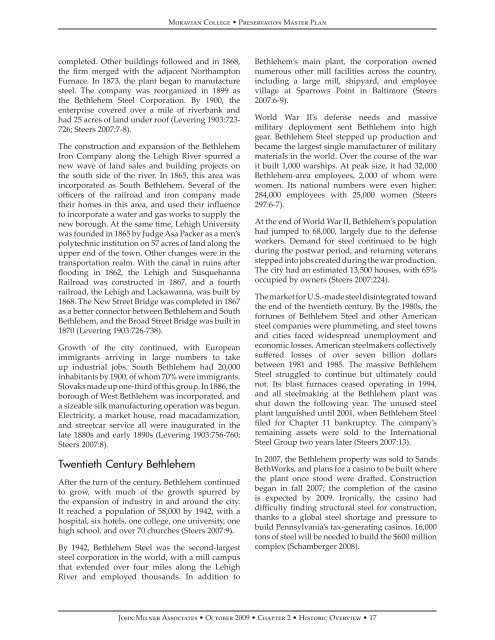Moravian Preservation Master Plan.indb - Society for College and ...
Moravian Preservation Master Plan.indb - Society for College and ...
Moravian Preservation Master Plan.indb - Society for College and ...
Create successful ePaper yourself
Turn your PDF publications into a flip-book with our unique Google optimized e-Paper software.
<strong>Moravian</strong> <strong>College</strong> • <strong>Preservation</strong> <strong>Master</strong> <strong>Plan</strong><br />
completed. Other buildings followed <strong>and</strong> in 1868,<br />
the firm merged with the adjacent Northampton<br />
Furnace. In 1873, the plant began to manufacture<br />
steel. The company was reorganized in 1899 as<br />
the Bethlehem Steel Corporation. By 1900, the<br />
enterprise covered over a mile of riverbank <strong>and</strong><br />
had 25 acres of l<strong>and</strong> under roof (Levering 1903:723-<br />
726; Steers 2007:7-8).<br />
The construction <strong>and</strong> expansion of the Bethlehem<br />
Iron Company along the Lehigh River spurred a<br />
new wave of l<strong>and</strong> sales <strong>and</strong> building projects on<br />
the south side of the river. In 1865, this area was<br />
incorporated as South Bethlehem. Several of the<br />
officers of the railroad <strong>and</strong> iron company made<br />
their homes in this area, <strong>and</strong> used their influence<br />
to incorporate a water <strong>and</strong> gas works to supply the<br />
new borough. At the same time, Lehigh University<br />
was founded in 1865 by Judge Asa Packer as a men’s<br />
polytechnic institution on 57 acres of l<strong>and</strong> along the<br />
upper end of the town. Other changes were in the<br />
transportation realm. With the canal in ruins after<br />
flooding in 1862, the Lehigh <strong>and</strong> Susquehanna<br />
Railroad was constructed in 1867, <strong>and</strong> a fourth<br />
railroad, the Lehigh <strong>and</strong> Lackawanna, was built by<br />
1868. The New Street Bridge was completed in 1867<br />
as a better connector between Bethlehem <strong>and</strong> South<br />
Bethlehem, <strong>and</strong> the Broad Street Bridge was built in<br />
1870 (Levering 1903:726-738).<br />
Growth of the city continued, with European<br />
immigrants arriving in large numbers to take<br />
up industrial jobs. South Bethlehem had 20,000<br />
inhabitants by 1900, of whom 70% were immigrants.<br />
Slovaks made up one-third of this group. In 1886, the<br />
borough of West Bethlehem was incorporated, <strong>and</strong><br />
a sizeable silk manufacturing operation was begun.<br />
Electricity, a market house, road macadamization,<br />
<strong>and</strong> streetcar service all were inaugurated in the<br />
late 1880s <strong>and</strong> early 1890s (Levering 1903:756-760;<br />
Steers 2007:8).<br />
Twentieth Century Bethlehem<br />
After the turn of the century, Bethlehem continued<br />
to grow, with much of the growth spurred by<br />
the expansion of industry in <strong>and</strong> around the city.<br />
It reached a population of 58,000 by 1942, with a<br />
hospital, six hotels, one college, one university, one<br />
high school, <strong>and</strong> over 70 churches (Steers 2007:9).<br />
By 1942, Bethlehem Steel was the second-largest<br />
steel corporation in the world, with a mill campus<br />
that extended over four miles along the Lehigh<br />
River <strong>and</strong> employed thous<strong>and</strong>s. In addition to<br />
Bethlehem’s main plant, the corporation owned<br />
numerous other mill facilities across the country,<br />
including a large mill, shipyard, <strong>and</strong> employee<br />
village at Sparrows Point in Baltimore (Steers<br />
2007:6-9).<br />
World War II’s defense needs <strong>and</strong> massive<br />
military deployment sent Bethlehem into high<br />
gear. Bethlehem Steel stepped up production <strong>and</strong><br />
became the largest single manufacturer of military<br />
materials in the world. Over the course of the war<br />
it built 1,000 warships. At peak size, it had 32,000<br />
Bethlehem-area employees, 2,000 of whom were<br />
women. Its national numbers were even higher:<br />
284,000 employees with 25,000 women (Steers<br />
297:6-7).<br />
At the end of World War II, Bethlehem’s population<br />
had jumped to 68,000, largely due to the defense<br />
workers. Dem<strong>and</strong> <strong>for</strong> steel continued to be high<br />
during the postwar period, <strong>and</strong> returning veterans<br />
stepped into jobs created during the war production.<br />
The city had an estimated 13,500 houses, with 65%<br />
occupied by owners (Steers 2007:224).<br />
The market <strong>for</strong> U.S.-made steel disintegrated toward<br />
the end of the twentieth century. By the 1980s, the<br />
<strong>for</strong>tunes of Bethlehem Steel <strong>and</strong> other American<br />
steel companies were plummeting, <strong>and</strong> steel towns<br />
<strong>and</strong> cities faced widespread unemployment <strong>and</strong><br />
economic losses. American steelmakers collectively<br />
suffered losses of over seven billion dollars<br />
between 1981 <strong>and</strong> 1985. The massive Bethlehem<br />
Steel struggled to continue but ultimately could<br />
not. Its blast furnaces ceased operating in 1994,<br />
<strong>and</strong> all steelmaking at the Bethlehem plant was<br />
shut down the following year. The unused steel<br />
plant languished until 2001, when Bethlehem Steel<br />
filed <strong>for</strong> Chapter 11 bankruptcy. The company’s<br />
remaining assets were sold to the International<br />
Steel Group two years later (Steers 2007:13).<br />
In 2007, the Bethlehem property was sold to S<strong>and</strong>s<br />
BethWorks, <strong>and</strong> plans <strong>for</strong> a casino to be built where<br />
the plant once stood were drafted. Construction<br />
began in fall 2007; the completion of the casino<br />
is expected by 2009. Ironically, the casino had<br />
difficulty finding structural steel <strong>for</strong> construction,<br />
thanks to a global steel shortage <strong>and</strong> pressure to<br />
build Pennsylvania’s tax-generating casinos. 16,000<br />
tons of steel will be needed to build the $600 million<br />
complex (Schamberger 2008).<br />
John Milner Associates • October 2009 • Chapter 2 • Historic Overview • 17

















